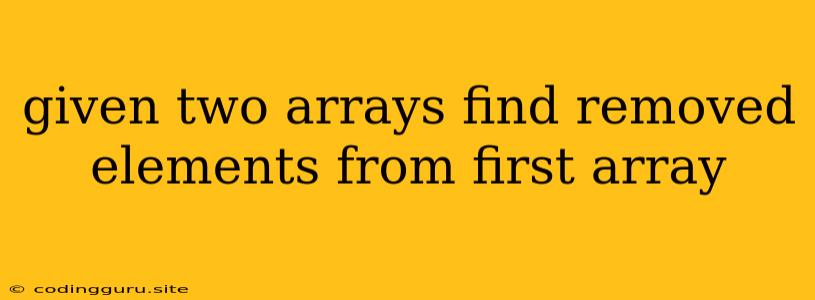Finding the Missing Pieces: Determining Removed Elements from Two Arrays
Imagine you have two arrays, one containing a complete set of elements, and the other missing some. Your task is to identify the elements that were removed from the first array. This common programming problem arises in various scenarios, such as data analysis, version control, and database comparison.
Understanding the Problem
Let's break down the problem statement:
- Given two arrays: You're provided with two arrays of data.
- Find removed elements: Your goal is to identify the elements that are present in the first array but absent in the second.
Example:
Array 1: [1, 2, 3, 4, 5] Array 2: [1, 3, 5]
The removed elements are: [2, 4]
Methods for Finding Removed Elements
Several approaches can be used to solve this problem. Here's a breakdown of two common methods:
1. Using a Set
This method leverages the properties of a set, which ensures unique elements. Here's the algorithm:
- Create a set from the first array: This set will contain all unique elements from the first array.
- Iterate through the second array: For each element in the second array, check if it exists in the set.
- Remove elements from the set: If an element from the second array is found in the set, remove it.
- Remaining elements in the set: The elements remaining in the set are the ones removed from the first array.
Code Example (Python):
def find_removed_elements(arr1, arr2):
set1 = set(arr1)
for element in arr2:
if element in set1:
set1.remove(element)
return list(set1)
arr1 = [1, 2, 3, 4, 5]
arr2 = [1, 3, 5]
removed_elements = find_removed_elements(arr1, arr2)
print(f"Removed elements: {removed_elements}")
Output:
Removed elements: [2, 4]
2. Using a Counter
This method utilizes the power of a counter to track element occurrences. Here's the algorithm:
- Create a counter for the first array: This counter will store the frequency of each element in the first array.
- Iterate through the second array: For each element in the second array, decrement its count in the counter.
- Elements with non-zero count: Elements with a count greater than zero in the counter indicate elements removed from the first array.
Code Example (Python):
from collections import Counter
def find_removed_elements(arr1, arr2):
counter = Counter(arr1)
for element in arr2:
if element in counter:
counter[element] -= 1
removed_elements = [element for element, count in counter.items() if count > 0]
return removed_elements
arr1 = [1, 2, 3, 4, 5]
arr2 = [1, 3, 5]
removed_elements = find_removed_elements(arr1, arr2)
print(f"Removed elements: {removed_elements}")
Output:
Removed elements: [2, 4]
Choosing the Right Method
The best method depends on your specific needs:
- Sets: This method is more efficient for large datasets as set operations are generally faster than iterating through lists.
- Counters: This method is useful if you need to keep track of the frequency of elements, as it provides additional information about the data.
Tips for Finding Removed Elements
- Consider element order: If the order of elements in the arrays is crucial, you might need to use a different approach that preserves order.
- Handle duplicates: If the arrays can contain duplicate elements, adjust the algorithms to handle multiple occurrences of the same element.
- Optimize for efficiency: For large datasets, optimize your code for performance by considering the efficiency of the chosen method and data structures.
Conclusion
Finding removed elements from two arrays is a fundamental problem in data manipulation. By understanding the techniques and applying the appropriate algorithms, you can efficiently identify the missing pieces and gain valuable insights from your data.
